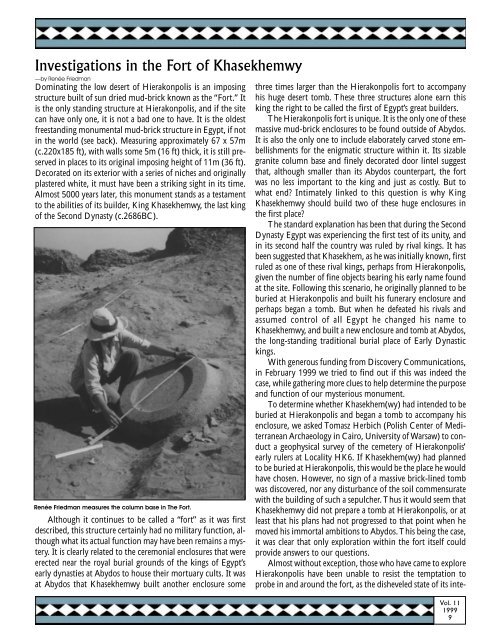Nekhen News 11 - Hierakonpolis Online
Nekhen News 11 - Hierakonpolis Online
Nekhen News 11 - Hierakonpolis Online
Create successful ePaper yourself
Turn your PDF publications into a flip-book with our unique Google optimized e-Paper software.
Investigations in the Fort of Khasekhemwy<br />
—by Renée Friedman<br />
Dominating the low desert of <strong>Hierakonpolis</strong> is an imposing<br />
structure built of sun dried mud-brick known as the “Fort.” It<br />
is the only standing structure at <strong>Hierakonpolis</strong>, and if the site<br />
can have only one, it is not a bad one to have. It is the oldest<br />
freestanding monumental mud-brick structure in Egypt, if not<br />
in the world (see back). Measuring approximately 67 x 57m<br />
(c.220x185 ft), with walls some 5m (16 ft) thick, it is still preserved<br />
in places to its original imposing height of <strong>11</strong>m (36 ft).<br />
Decorated on its exterior with a series of niches and originally<br />
plastered white, it must have been a striking sight in its time.<br />
Almost 5000 years later, this monument stands as a testament<br />
to the abilities of its builder, King Khasekhemwy, the last king<br />
of the Second Dynasty (c.2686BC).<br />
Renée Friedman measures the column base in The Fort.<br />
Although it continues to be called a “fort” as it was first<br />
described, this structure certainly had no military function, although<br />
what its actual function may have been remains a mystery.<br />
It is clearly related to the ceremonial enclosures that were<br />
erected near the royal burial grounds of the kings of Egypt’s<br />
early dynasties at Abydos to house their mortuary cults. It was<br />
at Abydos that Khasekhemwy built another enclosure some<br />
three times larger than the <strong>Hierakonpolis</strong> fort to accompany<br />
his huge desert tomb. These three structures alone earn this<br />
king the right to be called the first of Egypt’s great builders.<br />
The <strong>Hierakonpolis</strong> fort is unique. It is the only one of these<br />
massive mud-brick enclosures to be found outside of Abydos.<br />
It is also the only one to include elaborately carved stone embellishments<br />
for the enigmatic structure within it. Its sizable<br />
granite column base and finely decorated door lintel suggest<br />
that, although smaller than its Abydos counterpart, the fort<br />
was no less important to the king and just as costly. But to<br />
what end? Intimately linked to this question is why King<br />
Khasekhemwy should build two of these huge enclosures in<br />
the first place?<br />
The standard explanation has been that during the Second<br />
Dynasty Egypt was experiencing the first test of its unity, and<br />
in its second half the country was ruled by rival kings. It has<br />
been suggested that Khasekhem, as he was initially known, first<br />
ruled as one of these rival kings, perhaps from <strong>Hierakonpolis</strong>,<br />
given the number of fine objects bearing his early name found<br />
at the site. Following this scenario, he originally planned to be<br />
buried at <strong>Hierakonpolis</strong> and built his funerary enclosure and<br />
perhaps began a tomb. But when he defeated his rivals and<br />
assumed control of all Egypt he changed his name to<br />
Khasekhemwy, and built a new enclosure and tomb at Abydos,<br />
the long-standing traditional burial place of Early Dynastic<br />
kings.<br />
With generous funding from Discovery Communications,<br />
in February 1999 we tried to find out if this was indeed the<br />
case, while gathering more clues to help determine the purpose<br />
and function of our mysterious monument.<br />
To determine whether Khasekhem(wy) had intended to be<br />
buried at <strong>Hierakonpolis</strong> and began a tomb to accompany his<br />
enclosure, we asked Tomasz Herbich (Polish Center of Mediterranean<br />
Archaeology in Cairo, University of Warsaw) to conduct<br />
a geophysical survey of the cemetery of <strong>Hierakonpolis</strong>’<br />
early rulers at Locality HK6. If Khasekhem(wy) had planned<br />
to be buried at <strong>Hierakonpolis</strong>, this would be the place he would<br />
have chosen. However, no sign of a massive brick-lined tomb<br />
was discovered, nor any disturbance of the soil commensurate<br />
with the building of such a sepulcher. Thus it would seem that<br />
Khasekhemwy did not prepare a tomb at <strong>Hierakonpolis</strong>, or at<br />
least that his plans had not progressed to that point when he<br />
moved his immortal ambitions to Abydos. This being the case,<br />
it was clear that only exploration within the fort itself could<br />
provide answers to our questions.<br />
Almost without exception, those who have came to explore<br />
<strong>Hierakonpolis</strong> have been unable to resist the temptation to<br />
probe in and around the fort, as the disheveled state of its inte-<br />
Vol. <strong>11</strong><br />
1999<br />
9


